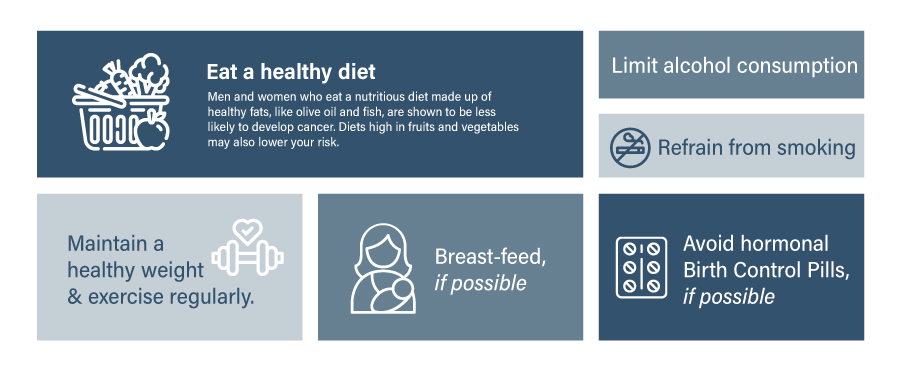
September 30, 2022
Breast cancer rates are increasing yearly and women are asking, “What can I do to prevent breast cancer?”. It’s vital now more than ever that you’re on the watch for cancer, knowing the risk factors, symptoms and how to reduce your risk. While some risk factors can’t be changed, like a family history of breast cancer, you can make lifestyle modifications to help guard you against cancer.
Risk factors
Understanding what risk factors you have is key to cancer prevention and efficient treatment. If you have a family history of breast cancer, you can begin self-monitoring and screening at an earlier age. While this won’t prevent cancer, it will enable you to find and begin treatment of the disease faster, giving you the best chance of successful treatment.
What are some of the most common risk factors of breast cancer?
- Being female
- Being over 55 (aging)
- Family history of breast cancer
- Inherited mutated BRCA1 and BRCA2 genes
- Drinking alcohol
- Obesity
- Having never been pregnant
Having one or more of these doesn’t necessarily mean cancer is in the cards for you. However, those who fall into the categories listed above are at a greater risk for cancer than those who don’t. Knowing you’re at risk and why can empower you to take steps to monitor your body more closely for any changes and allow you to seek medical attention when you find them.

How to Monitor for Breast Cancer
Monitoring for breast cancer includes getting routine screenings from your health care providers and performing frequent self-exams. Coryell Health recommends you begin scheduling annual screenings once you turn 40.
Medical professionals strongly encourage women to conduct regular self-examinations to check for changes in their breasts. To do so, follow these steps:
- Examine breasts in the mirror and check for changes in shape, size and color.
- Perform a physical examination of your breasts using three fingers moving in circular motions towards the nipple.
Symptoms of Breast Cancer
What exactly are you looking for when monitoring for breast cancer? Any sudden changes in your breast shape or new lumps should be cause for a follow-up with your health care provider, as well as changes to your nipple or new texture variations. Don’t be alarmed, as shifts in your breast can be caused by several other factors unrelated to cancer, but do consult your doctor right away.
Reducing Your Risk
You can never fully reduce or remove your chance of cancer, but there are steps you can take to lower your risks.

Some women are at a higher risk of breast cancer due to family history or inherited mutated genes. Doctors might suggest these women undergo a bilateral prophylactic mastectomy, or the removal of both breasts. This procedure occurs before a breast cancer diagnosis and has been proven to reduce the risk of cancer by 90 to 95% in those with high risk.

Treating and reducing your risk of cancer successfully starts with you. If it’s been a while since you or a loved one has had their regularly scheduled breast examination, now’s the time. Our health care professionals are ready to provide you with a mammogram with no referral necessary. We offer the latest technology, including 3D mammograms, which studies show locate one more patient with cancer for every 1,000 women screened. Give us a call today at 254-248-6238 to schedule your 20-minute mammogram appointment or visit our website to learn more about 3D mammograms.
 Skip to content
Skip to content
